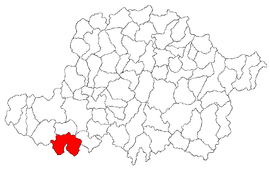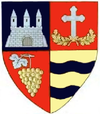
Timiș is a county (județ) of western Romania on the border with Hungary and Serbia, in the historical region Banat, with the county seat at Timișoara. It is the westernmost and the largest county in Romania in terms of land area. The county is also part of the Danube–Criș–Mureș–Tisa Euroregion.

Arad County is an administrative division (judeţ) of Romania roughly translated into county in the western part of the country on the border with Hungary, mostly in the region of Crișana and few villages in Banat. The administrative center of the county lies in the city of Arad. The Arad County is part of the Danube–Criș–Mureș–Tisa Euroregion.

Banat is a geographical and historical region straddling between Central and Eastern Europe that is currently divided among three countries: the eastern part lies in western Romania ; the western part in northeastern Serbia ; and a small northern part lies within southeastern Hungary.
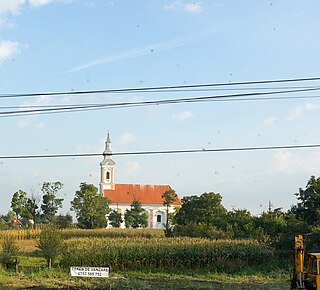
Becicherecu Mic is a commune in Timiș County, Romania. It is composed of a single village, Becicherecu Mic. It also included Dudeștii Noi until 2004, when it was split off to form a separate commune. Its name means "Small Becicherec", as opposed to the "Great Becicherec", located in Serbia and renamed Zrenjanin in 1946.

Dudeștii Vechi is a commune in Timiș County, Romania. It is composed of three villages: Cheglevici, Colonia Bulgară and Dudeștii Vechi. It also included Vălcani until 2005, when it was split off to form a separate commune. Dudeștii Vechi is mostly populated by Banat Bulgarians (Palćene), a regional minority group of ethnic Bulgarians that profess Roman Catholicism, who came from northern Bulgaria, and who are descendants of Paulicians that settled in the area around 1738.
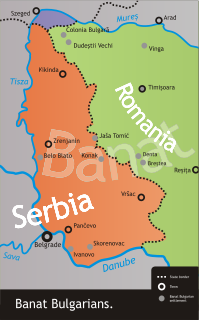
The Banat Bulgarians, also known as Bulgarian Roman Catholics and Bulgarians Paulicians or simply as Paulicians, are a distinct Bulgarian minority group which since the Chiprovtsi Uprising in the late 17th century began to settle in the region of the Banat, which was then ruled by the Habsburgs and after World War I was divided between Romania, Serbia, and Hungary. Unlike most other Bulgarians, they are Roman Catholic by confession and stem from groups of Paulicians and Roman Catholics from modern northern and northwestern Bulgaria.

Comloșu Mare is a commune in Timiș County, Romania. It is composed of three villages: Comloșu Mare, Comloșu Mic and Lunga.

Sânandrei is a commune in Timiș County, Romania. It is composed of three villages: Carani, Covaci and Sânandrei.

Dumbrăvița is a commune in Timiș County, Romania. It is composed of a single village, Dumbrăvița. One of the most developed and rich communes in Romania, Dumbrăvița has become in recent years a suburb of Timișoara.

Giroc is a commune in Timiș County, Romania. It is composed of two villages, Chișoda and Giroc. It is located near Timișoara, south of the city.

Belinț is a commune in Timiș County, Romania. It is located between the cities of Timișoara and Lugoj and is composed of four villages: Babșa, Belinț, Chizătău and Gruni.
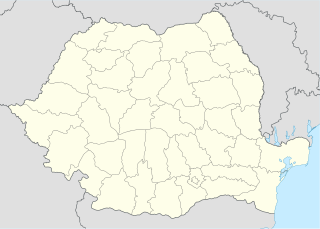
Frumușeni is a commune in Arad County, Romania. It lies in the north-eastern part of the Vinga Plateau. It is composed of two villages, Aluniș and Frumușeni. These were part of Fântânele Commune until 2004, when they were split off.

Denta is a commune in Timiș County, Romania. It is composed of four villages: Breștea, Denta, Rovinița Mare and Rovinița Mică.

Liebling is a commune in Timiș County, Romania. It is composed of three villages: Cerna, Iosif and Liebling.

Orțișoara is a commune in Timiș County, Romania. It is composed of four villages: Călacea, Cornești, Orțișoara and Seceani.

Periam is a commune in Timiș County, Romania. It is composed of a single village, Periam, and also included Pesac until it broke off as a separate commune in 2007.

Variaș is a commune in Timiș County, Romania. It is composed of three villages: Gelu, Sânpetru Mic and Variaș.

Bulgarians are a recognized minority in Romania, numbering 7,336 according to the 2011 Romanian census, down from 8,025 in 2002. Despite their low census number today, Bulgarians from different confessional and regional backgrounds have had ethnic communities in various regions of Romania, and during the Middle Ages Bulgarian culture has exerted considerable influence on its northern neighbour. According to one estimate, Romanian citizens of Bulgarian origin number around 250,000.

Timiș-Torontal was a county in the Kingdom of Romania. Its capital was Timișoara. The territory of the county had been transferred to Romania in 1920 from the Kingdom of Hungary under the Treaty of Trianon.
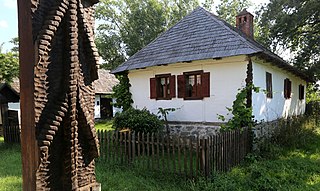
The Banat Village Museum is an open-air ethnographic museum in northeastern Timișoara, at the edge of the Green Forest. Spread over an area of 17 ha, the museum is designed as a traditional Banat village and includes peasant households belonging to various ethnic groups in Banat, buildings with social function of the traditional village, folk art installations and workshops.

